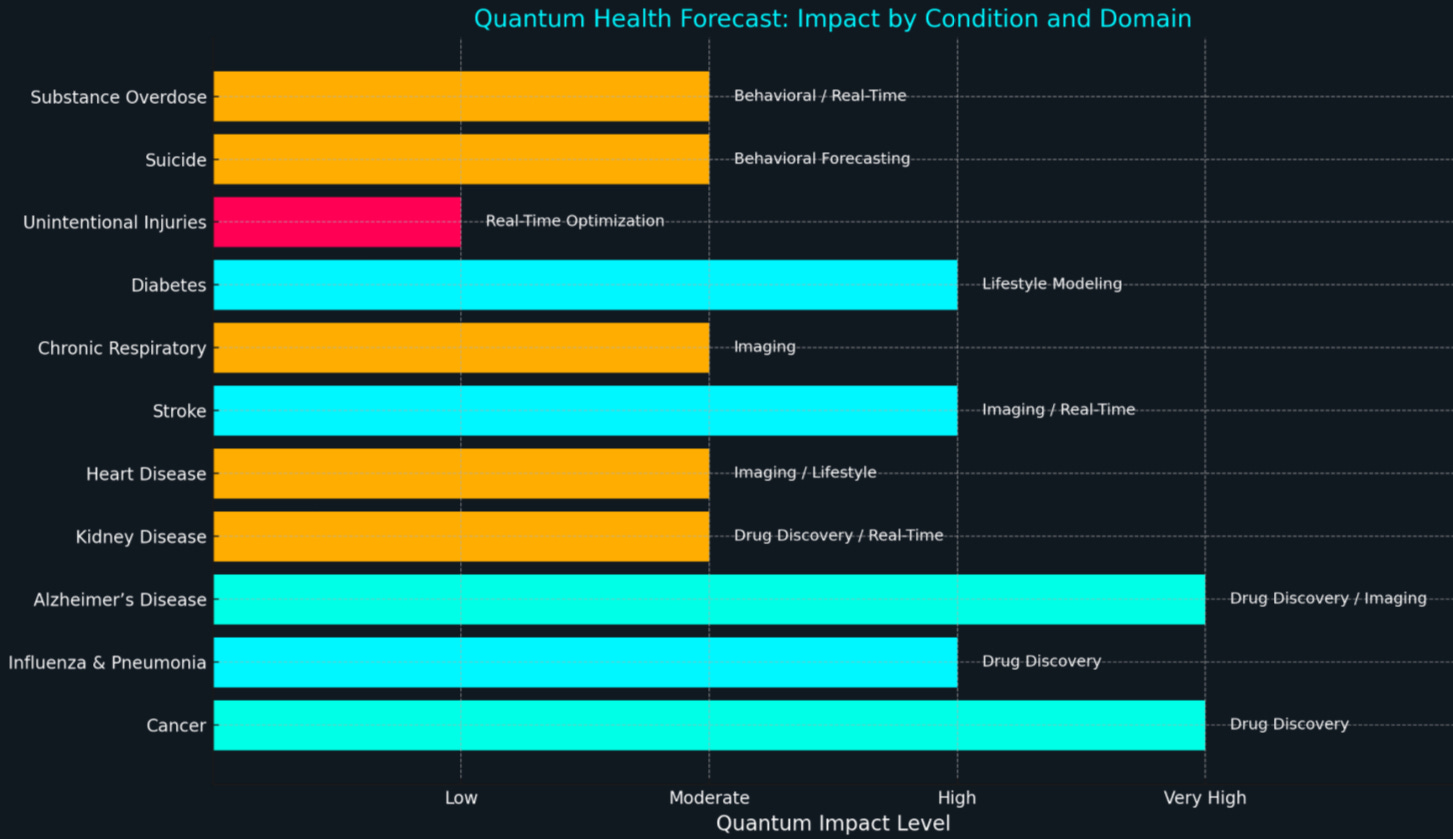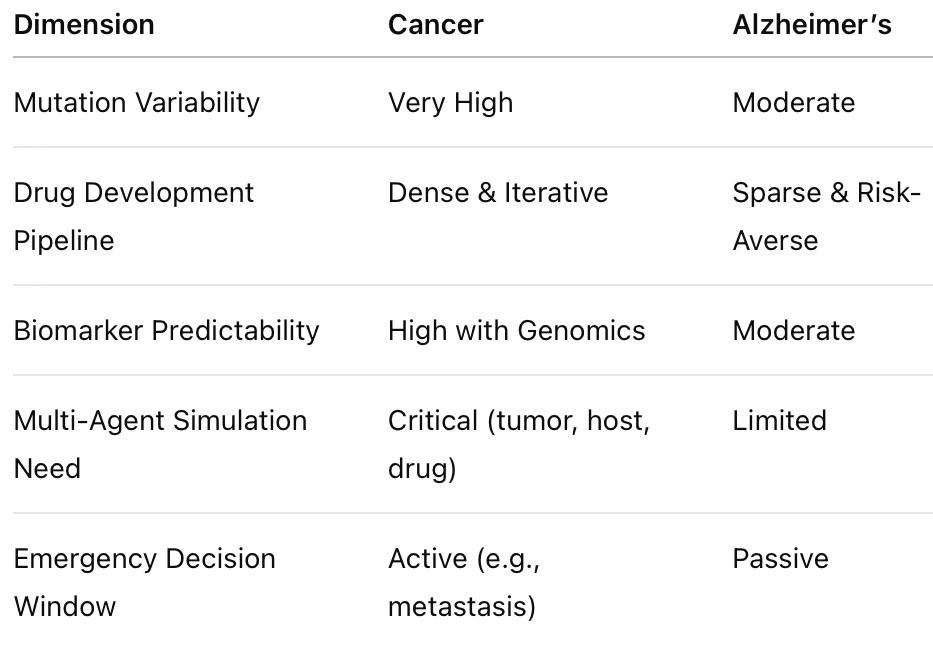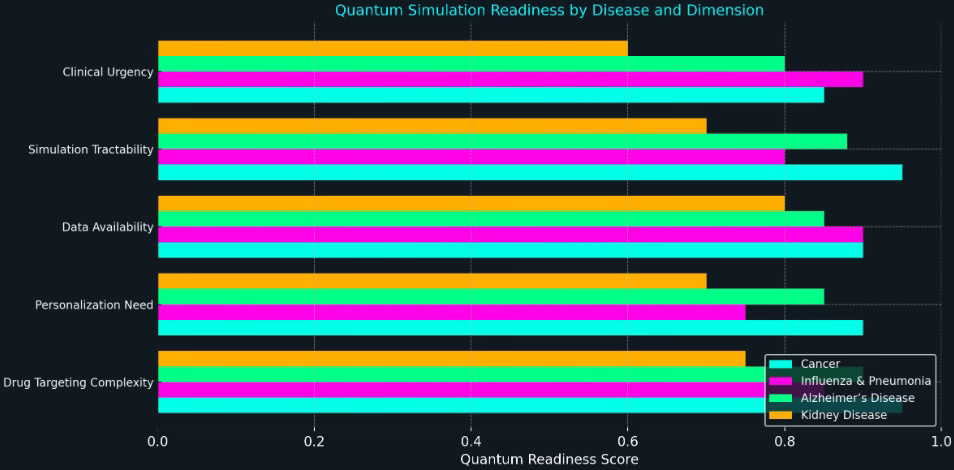MCAI Health Vision: Cancer and Quantum Computing Forecast
Comparative evaluation of quantum simulation readiness across core therapeutic domains based on five critical performance indicators
Companion study MindCast AI Health Vision: Alzheimer’s and Quantum Computing Forecast, Comparative evaluation of quantum simulation readiness across neurodegenerative domains based on five critical performance indicators (April 25, 2025)
Comparative evaluation of quantum simulation readiness across neurodegenerative domains based on five critical performance indicators
Executive Summary MindCast AI LLC (MCAI) presents this white paper in response to accelerating breakthroughs in quantum computing, including Microsoft's development of the Majorana 1 chip (source). These innovations signal a profound shift in how we simulate biology, personalize treatment, and reimagine healthcare systems. Quantum Health Vision is MindCast AI's forecast framework for evaluating when—and how—quantum computing will meaningfully alter outcomes across the top causes of death in the United States.
MCAI is a cognitive AI company specializing in the simulation of judgment, behavior, and foresight. Its patented system integrates Cognitive Digital Twins (CDTs), probabilistic forecasting, and adaptive modeling. Through a suite of Vision Functions, MCAI delivers simulation tools for legal risk, legacy planning, institutional behavior, and now—precision medicine. Quantum Health Vision applies this architecture to healthcare by integrating quantum systems with CDT models of patients, treatments, and response ecosystems. Each of the three entities—patient, treatment, and quantum engine—is assigned a CDT to enable adaptive, interactive simulation across decision layers.
I. Overview: Drug Discovery & Treatment Simulation
Understanding where quantum computing has the greatest likelihood of delivering measurable health impact starts with drug discovery and treatment simulation. Among all potential application areas, this domain shows the clearest match between the complexity of the problem and the advantage offered by quantum systems.
Specifically, quantum computers excel at simulating molecular dynamics, protein folding, and patient-specific pharmacological responses. These capabilities allow for precise targeting of biochemical pathways, acceleration of compound screening, and the ability to personalize regimens far beyond classical capabilities. This makes the application domain foundational for diseases where treatment effectiveness hinges on finding the right molecule, the right pathway, and the right dose—all within a shifting biological environment.
Diseases like cancer, influenza and pneumonia, Alzheimer’s disease, and kidney disease stand out. Their molecular roots and variability make them ideal candidates for quantum-enhanced drug discovery and adaptive therapy modeling.
Insight: The diseases listed above all require high-resolution biochemical targeting and patient-specific modeling—making drug discovery the most critical domain for quantum medical breakthroughs.
Cancer emerges as the clearest strategic focus. It is not only one of the most prevalent and deadly diseases, but also the one most aligned with the computational strengths of quantum simulation. Cancer is driven by chaotic molecular structures, dynamic mutation pathways, and evolving resistance patterns. These traits, while challenging for classical systems, are precisely the kind of high-dimensional complexity quantum computing was built to explore.
While both cancer and Alzheimer’s rank as “Very High” in quantum applicability, cancer holds a broader and deeper field of quantum engagement.
Cancer’s mutation-driven volatility and high treatment response diversity create more points of simulation leverage—meaning quantum computing can do more, earlier, and more often. Alzheimer's simulation relies more on long-term progression modeling and protein folding, both of which are important but evolve more slowly.
The remainder of this paper focuses specifically on cancer as a proving ground for quantum healthcare. Quantum will likely have 30–50% greater systemic impact on cancer than Alzheimer’s over the next two decades, due to its higher simulation throughput, treatment multiplicity, and clinical urgency.
II. Simulation Framework: Triadic Model of Precision Care
To simulate health decisions under quantum conditions, MCAI deploys a triadic loop of simulation. Each entity—patient, quantum system, and treatment—is modeled as a dynamic agent capable of interaction and feedback. These digital twins do not exist in isolation; they are entangled in a loop of perception, decision, and recalibration that mirrors real-world clinical dynamics.
This structure reflects the adaptive nature of modern healthcare, where medical interventions must evolve in real time based on a patient’s biology, cognition, and lived environment. Quantum computing provides the system speed and precision to make this model scalable. Meanwhile, CDTs preserve behavioral coherence, emotional readiness, and preference sensitivity within the simulation.
Insight: Modeling each participant in the healthcare process as a cognitive digital twin allows real-time refinement, learning, and trust calibration.
Quantum Health Vision operates using a triadic simulation loop:
Patient CDT – Simulates behavioral, emotional, genetic, and physiological response to care.
Quantum Simulation Engine – Models biomolecular pathways, protein-ligand interactions, and treatment evolution.
Treatment CDT – Treats therapies as adaptive agents, forecasting efficacy, side effects, and interaction with patient cognition.
These systems are connected in a dynamic feedback loop—each CDT evolves based on outcomes, adherence, environmental feedback, and new biological inputs. This loop is not just responsive but anticipatory, enabling simulation cycles that adjust prior to failure points in treatment.
The triadic model transforms medicine into a living system of cognitive, physical, and computational agents, dramatically improving treatment fit and system foresight.
III. Deep Dive: Quantum Computing & Cancer
Cancer is one of the most complex and lethal diseases in medicine today. Its causes, progression, and treatment response are highly individualized and constantly evolving. Traditional models struggle to keep pace with the volume of genomic and clinical variability cancer presents. Quantum computing offers a new set of tools capable of simulating protein interactions, mutation impacts, and therapeutic mechanisms at a resolution never before possible.
Because cancer is fundamentally a disease of molecular dysfunction and mutational chaos, it is uniquely suited for quantum intervention. Quantum-enabled drug discovery platforms can model billions of molecular interactions in parallel and forecast the likelihood of therapeutic success based on real-time biomarker input. Combined with CDTs of the patient and the treatment itself, we can simulate dynamic response scenarios before a therapy is administered.
Insight: Cancer’s molecular instability and adaptive resistance mechanisms create a perfect test bed for the parallelism and precision of quantum computing.
Quantum Health Vision identifies cancer as the most promising candidate for a functional cure through quantum computing, due to its simulation tractability, research maturity, and patient-specific variability. It will likely be the first domain where the full CDT-quantum feedback model is validated at scale.
IV. Strategic Levers to Accelerate Progress
Realizing the potential of quantum health interventions will depend on more than raw hardware power. The transition from theoretical breakthroughs to clinical impact requires synchronized evolution across technology, regulation, institutional trust, and public narrative. Each lever below represents a domain of systemic alignment that will either accelerate or constrain quantum adoption.
Quantum systems must scale reliably through advances in error correction and the expansion of stable, fault-tolerant qubits. Equally important is the development of standards that translate biological structures and patient states into quantum-readable inputs. These integrations will enable faster iteration, more adaptive pipelines, and tighter feedback between data generation and therapeutic simulation.
Insight: The key to scalable impact lies in aligning quantum infrastructure with institutional credibility, regulatory foresight, and CDT-led trust calibration.
Error-corrected qubits to support deep, stable molecular simulations.
Quantum-biomedical interface standards for translating biological data into quantum systems.
Hybrid classical-quantum AI pipelines to prioritize and test compounds efficiently.
Pan-cancer genomic databases mapped to quantum-simulation formats.
Quantum-aware regulatory sandboxes to support clinical translation.
Narrative trust infrastructure via CDT simulation of patient behavior and emotional response to treatment.
Accelerating quantum health impact requires not only better code, but deeper coordination—across data, regulation, cognition, and institutional adoption.
V. Emergency Medicine & Quantum Simulation
While much attention focuses on chronic disease, quantum computing also promises powerful applications in time-critical care. Emergency medicine depends on fast, context-specific decisions under pressure. With the integration of CDTs and quantum models, emergency systems can forecast patient deterioration, optimize triage decisions, and dynamically route resources for maximal survival impact.
To create a coherent bridge between domains, it’s important to note that many of the breakthroughs developed for cancer—such as dynamic biomarker-driven decision loops and treatment CDTs—have direct applicability in emergency contexts. For instance, trauma or stroke scenarios often involve patient-specific constraints, real-time risk modeling, and drug-response uncertainties. These are the same domains where quantum-enhanced simulations and CDT infrastructure already demonstrate strong potential. What differentiates emergency care is the need for immediate deployment of these systems under severe time constraints.
Quantum Health Vision imagines a future where hospitals use quantum-augmented ER triage systems to simulate every patient’s trajectory upon arrival. Combined with treatment CDTs, these systems can identify drug interactions, simulate safe doses, and prioritize urgent interventions based on probabilistic outcomes—all within seconds. This transforms emergency care from reactive to predictive.
Insight: Quantum systems, when calibrated through CDT logic, offer emergency medicine the ability to anticipate crises before they manifest and personalize interventions under extreme time pressure.
Optimize ambulance routing and ER overflow using real-time scenario modeling.
Simulate trauma care or stroke responses based on biometric signal trends.
Predict drug interactions and safe dosages using quantum probabilistic engines.
In emergency medicine, the quantum-CDT loop enables rapid simulations that save lives under stress, adapting protocols to individuals in real-time and reducing preventable clinical errors.
VI. Implications & Next Steps
Quantum Health Vision repositions healthcare as a computationally forecastable, cognitively adaptive system. By treating patients, treatments, and simulations as agents in a feedback loop, MCAI reframes care as a dynamic system of evolving intelligence. This opens the door to a new paradigm where medicine is not a fixed protocol but a continuously optimized process.
MCAI’s CDT infrastructure will serve as the interpretive layer that allows institutions to trust quantum outputs, align them with real-world behaviors, and calibrate them against emotional and legal expectations. As more diseases are modeled in this way, and more data flows into CDT-quantum systems, adaptive foresight will become the default—not the exception.
Insight: Healthcare’s future lies in high-fidelity simulation—of both molecules and minds—unified through trust-based computational architecture.
For pharma, biotech, policy, and AI innovators, Quantum Health Vision provides a path to:
De-risk high-cost drug development using quantum forecasting.
Create real-time personalized medicine using CDT feedback loops.
Build systemic healthcare resilience through precision simulation.
Ultimately, as quantum machines evolve in tandem with biomedical data and CDT calibration, MCAI envisions a future in which cancer is not only curable, but computationally anticipatable—and dynamically managed at scale. Quantum Health Vision offers a navigational framework for the next 20 years of medicine—where quantum systems, cognitive models, and precision therapies form the new standard of care.
Prepared by Noel Le, Founder | Architect of MindCast AI LLC. Noel holds a background in law and economics, behavioral economics and intellectual property.
LinkedIn: https://www.linkedin.com/in/noelleesq
mindcast.ai@icloud.com







